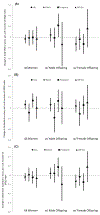Air pollution mixture exposure during pregnancy and postpartum psychological functioning: racial/ethnic- and fetal sex-specific associations
- PMID: 39567710
- PMCID: PMC12092737
- DOI: 10.1038/s41370-024-00726-2
Air pollution mixture exposure during pregnancy and postpartum psychological functioning: racial/ethnic- and fetal sex-specific associations
Abstract
Background: Prenatal air pollution (AP) exposure has been linked to postpartum psychological functioning, impacting health outcomes in both women and children. Extant studies primarily focused on individual pollutants.
Objective: To assess the association between prenatal exposure to a mixture of seven AP components and postpartum psychological functioning using daily exposure data and data-driven statistical methods.
Methods: Analyses included 981 women recruited at 24.0 ± 9.9 weeks gestation and followed longitudinally. We estimated prenatal daily exposure levels for constituents of fine particles [elemental carbon (EC), organic carbon (OC), nitrate (NO3-), sulfate (SO42-), ammonium (NH4+)], nitrogen dioxide (NO2), and ozone (O3) using validated global 3-D chemical-transport models and satellite-based hybrid models based on residential addresses. Edinburgh Postnatal Depression Scale (EPDS) was administered to participants to derive a total EPDS score and the subconstruct scores for anhedonia and depressive symptoms. A distributed lag model (DLM) was employed within Bayesian Kernel Machine Regression (BKMR) to develop time-weighted exposure profile for each pollutant. These exposures were then input into a Weighted Quantile Sum (WQS) regression to estimate an overall mixture effect, adjusted for maternal age, education, race/ethnicity, season of delivery, and delivery year. Effect modification by race/ethnicity and fetal sex was also examined.
Results: Women were primarily Hispanic (51%) and Black (32%) reporting ≤12 years of education (58%). Prenatal exposure to an AP mixture was significantly associated with increased anhedonia subscale z-scores, particularly in Hispanics (β = 0.07, 95%CI = 0.004-0.13, per unit increase in WQS index). It was also borderline associated with increased total EPDS (β = 0.11, 95%CI = 0.00-0.22) and depressive symptom subscale (β = 0.09, 95%CI = -0.02 to 0.19) z-scores, particularly among Hispanic women who gave birth to a male infant. Sulfate (SO42-), O3 and OC were major contributors to these associations.
Impact: This study utilizes an advanced data-driven approach to examine the temporally- and mixture-weighted effects of prenatal air pollution exposure on postpartum psychological functioning. We found that exposure to a prenatal air pollution mixture predicted poorer postpartum psychological functioning, particularly anhedonia symptoms in Hispanic women. Findings underscore the importance of considering both exposure mixtures as well as potential modifying factors to better help identify particular pollutants that drive effects and susceptible populations, which can inform more effective intervention strategies.
Keywords: Air pollution; Health disparities; Mixture; Postpartum depression; Prenatal exposure.
© 2024. The Author(s), under exclusive licence to Springer Nature America, Inc.
Conflict of interest statement
Competing interests: The authors declare no competing interests. Ethics approval and consent to participate: All study protocols were reviewed and approved by the Program for the Protection of Human Subjects at the Icahn School of Medicine at Mount Sinai for the ACCESS project (IRB#12-00661) and the PRISM project (IRB#12-00875). Informed written consent was obtained from all participants. The authors confirm that all procedures contributing to this work comply with the ethical standards as outlined in the Declaration of Helsinki.
Figures


Similar articles
-
Prenatal ambient air pollutant mixture exposure and neurodevelopment in urban children in the Northeastern United States.Environ Res. 2023 Sep 15;233:116394. doi: 10.1016/j.envres.2023.116394. Epub 2023 Jun 12. Environ Res. 2023. PMID: 37315758 Free PMC article.
-
Prenatal exposure to air pollution and BWGA Z-score: Modifying effects of placenta leukocyte telomere length and infant sex.Environ Res. 2024 Apr 1;246:117986. doi: 10.1016/j.envres.2023.117986. Epub 2023 Dec 23. Environ Res. 2024. PMID: 38145728 Free PMC article.
-
Association Between Ambient Air Pollution and Birth Weight by Maternal Individual- and Neighborhood-Level Stressors.JAMA Netw Open. 2022 Oct 3;5(10):e2238174. doi: 10.1001/jamanetworkopen.2022.38174. JAMA Netw Open. 2022. PMID: 36282504 Free PMC article.
-
Debriefing interventions for the prevention of psychological trauma in women following childbirth.Cochrane Database Syst Rev. 2015 Apr 10;2015(4):CD007194. doi: 10.1002/14651858.CD007194.pub2. Cochrane Database Syst Rev. 2015. PMID: 25858181 Free PMC article.
-
Application of the navigation guide systematic review methodology to evaluate prenatal exposure to particulate matter air pollution and infant birth weight.Environ Int. 2021 Mar;148:106378. doi: 10.1016/j.envint.2021.106378. Epub 2021 Jan 25. Environ Int. 2021. PMID: 33508708 Free PMC article.
References
-
- WHO. World Health Organizatioin (WHO). WHO recommendations on maternal and newborn care for a positive postnatal experience. https://www.who.int/publications/i/item/9789240045989 [Accessed December 2, 2023]. 2022. - PubMed
-
- Jin J, Xu Z, Beevers SD, Huang J, Kelly F, Li G. Long-term ambient ozone, omega-3 fatty acid, genetic susceptibility, and risk of mental disorders among middle-aged and older adults in UK biobank. Environ Res. 2023;243:117825. - PubMed
MeSH terms
Substances
Grants and funding
LinkOut - more resources
Full Text Sources
Medical

